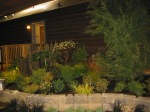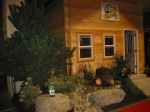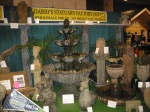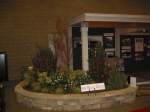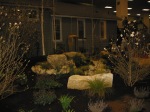- Straight from the box
- With cylinder attached
- Ready for use
- Flame on!
- Lots of flame
- More flame
- A bit of a stretch
- More flame
- After the burn
- Afterwards
- In the blueberries
- Lotsa burn
- More burn
- More burn
- Stil more burn
- Final burn shot
- Driveway mix filler
- Sealing the weeds
- More mix
- Filled in
- Last shot
I got a new toy yesterday and I’m so happy. I’ve wanted one of these since I saw one in a gardening catalog a few months ago, and I finally found one in a local nursery on the 10% off Senior’s Day so we got a deal on it. It’s a Mini Dragon Weed Eater and it uses flame to kill weeds. It’s amazing! What used to take hours of backbreaking labor now takes a few minutes of hot fire. Wow!
I really do try to keep up with the weeds in our garden. I’m always pulling them out when they’re small so they don’t get too big as to be too much work. But one side of the yard is infested with serious grass and I just can’t get in to pull it out. So I’ve gone in a few times a year trying to get to them. I can only do this in the late spring or fall when the trees are bare so I can get at them. That time is now folks!
We first tried using a regular propane torch like you use for soldering and it work OK but it had such a small area of fire that it would have taken ages to do it. Plus it’s too hard to get back inside of the plants at the back of the bed. So we decided it was time to go for the real thing.
Off we went to the nursery and got the Weed Dragon Mini version. There’s a larger one that has a tank on a cart with 10 feet or so of hose so you can do big jobs. But for our little garden this mini one is just perfect. It has a super hot fire and a large outlet and just wilts the leaves in place immediately. Just a few passes and it’s over.
They say that you just need to flash over the weeds with a flame and it kills them but I was more intense and actually burned them to the ground where I could. The wand makes it easy to get in behind the Pine and other plants that are too dense to really garden under so far back in the bed against the fence. I had to be careful so as not to burn the fence and we kept a jug of water handy all the time just in case, as you can see in the picture.
I showed the whole Weed Dragon as it first came from the box, and then with the tank on. It’s just one of the little 1 pound ones you see for propane stoves and such. It’s lightweight and easy to balance in your hand and you have to hold it at a 6:00 to 8:00 position or it’ll flame out so you have to use some care with it. Don’t want to lose the flame or start a fire!
I’ve shown some photos of what it looks like to actually use it and how far the flame will reach and spread out or how it will pin point and get really hot in a certain place. I shot several photos of the weeds after I burned them out and you can still see some green but it’s fading fast. I did these all yesterday and this morning you can see the weeds still sticking out from the edge of the filler, but they’re dying you can tell.
After I killed all the grasses we got some special driveway mix filler rock. It’s crushed 5/8″ inch gravel with a binder in it just for drives but it’s perfect for foundations for fountains or for decks and it works great to seal up areas like this where you don’t want anything to grow. The last few shots show what it looks like with the filler in place. It’s the end for weeds growing there now. I hope…
So all we have to do is go back a couple times a year with the Weed Dragon and top off the area near the fence and the filler. Anything that tries to come up again will be fried and won’t bother us again, and if it does we’ll fry it again. No mercy for these grasses I’m afraid.
Just using it right now in the back of the bed has been a tricky job but I think once I get more used to the Weed Dragon I’ll be able to use it closer to some of the plants and kill more weeds that way. But I’m being cautious at first. Don’t wanna catch any pine needles on fire!
The timing for this is pretty remarkable for me personally. On Monday my back went into spasm and I couldn’t walk that night. So I got some acupuncture on Tuesday and yesterday I felt OK enough to do the work, but it got me in the end and last night I went into spasm again. Sigh. This hasn’t happened in years and I’m a bit worried about it.
Sometimes I get totally crippled by the back spasms and I hope that doesn’t happen now. Even using the weed dragon when I feel like this would be too much for me. So I”ll be careful today and when I can use it again thsi tool will save me from hurting myself again in the future. Just no more rock for awhile, thank you…
So one more pass and we’re done with the weeding in this area for the year I hope. We have another bad patch in the back that we want to try it on too and it’ll save us untold hours of hard work that will now be easy to do. The Weed Dragon is advertised as being organic and doesn’t use herbicides and will still kill the grasses. It seems like a win – win to me.
These cost around 60 bucks, which is a lot, but I think it’ll be worth it for the saving on our bodies over time. I’m sure we’ll find other uses for it too as time goes on. They work to defrost driveways or walks and it can be used for that too. It’s a very versatile tool. I hope it does work as well as advertised and as it seems to do so far. If so we’ll have cut our weeding time back a lot. Yay for appropriate technology!
Happily Frying the Weeds! 😉
Steve






















